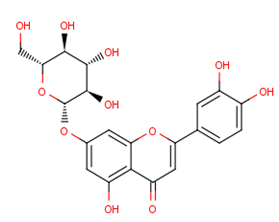
Cynaroside
CAS No. 5373-11-5
Cynaroside( Luteolin 7-glucoside | Luteolin 7-O-β-D-glucoside )
Catalog No. M17108 CAS No. 5373-11-5
Cynaroside is found in anise. Luteolin 7-glucoside is a constituent of the leaves of Capsicum annuum (red pepper).
Purity : >98% (HPLC)
 COA
COA
 Datasheet
Datasheet
 HNMR
HNMR
 HPLC
HPLC
 MSDS
MSDS
 Handing Instructions
Handing Instructions
| Size | Price / USD | Stock | Quantity |
| 5MG | 69 | In Stock |


|
| 10MG | 105 | In Stock |


|
| 25MG | 213 | In Stock |


|
| 50MG | 375 | In Stock |


|
| 100MG | 560 | In Stock |


|
| 500MG | 1197 | In Stock |


|
| 1G | Get Quote | In Stock |


|
Biological Information
-
Product NameCynaroside
-
NoteResearch use only, not for human use.
-
Brief DescriptionCynaroside is found in anise. Luteolin 7-glucoside is a constituent of the leaves of Capsicum annuum (red pepper).
-
DescriptionCynaroside is found in anise. Luteolin 7-glucoside is a constituent of the leaves of Capsicum annuum (red pepper). Cynaroside is a flavone, a flavonoid-like chemical compound. It is a 7-O-glucoside of luteolin and can be found in dandelion coffee, in Ferula varia and F. foetida in Campanula persicifolia and C. rotundifolia and in Cynara scolymus (artichoke).
-
In VitroCynaroside promots macrophage phenotypic transition from pro-inflammatory M1 to anti-inflammatory M2, and mitigates sepsis-associated liver inflammatory damage.Cynaroside reduces binding of PKM2 to hypoxia-inducible factor-1α (HIF-1α) by abolishing translocation of PKM2 to the nucleus and promoting PKM2 tetramer formation, as well as suppressing phosphorylation of PKM2 at Y105 in vivo and in vitro.Cynaroside restores pyruvate kinase activity, inhibits glycolysis-related proteins including PFKFB3, HK2 and HIF-1α, and inhibits glycolysisrelated hyperacetylation of HMGB1 in septic liver.Cynaroside protects H9c2 cells against H2O2-induced apoptosis by decreasing ROS generation and inhibiting caspase activation in both the mitochondrial and death receptor pathways.Cynaroside maintains mitochondrial function by regulating Bcl-2 protein expression, as well as JNK and P53 expression. Western Blot Analysis Cell Line:RAW264.7 cell Concentration:5μM, 10μM Incubation Time:2 h Result:Reduced expression levels of IL-1β, IL-6 and TNF-α and HMGB1, suppressed M1 polarized phenotype in RAW264.7 cells.Immunofluorescence Cell Line:RAW264.7 cell Concentration:Incubation Time:4 h Result:Decreased PKM2 nuclear translocation in hepatic macrophages of septic mice.RT-PCRCell Line:RAW264.7 cell Concentration:2.5μM, 5μM, 10μM Incubation Time:Result:Increased increased expression levels of M2 markers Arg-1, IL-10 and CD206.Cell Viability Assay Cell Line:H9c2 cells Concentration:25, 50, 100 μg/mL Incubation Time:4 h Result:Protected H9c2 cells from oxidative stress-induced cell injury.Apoptosis Analysis Cell Line:H9c2 cells Concentration:25, 50, 100 μg/mL Incubation Time:4 h Result:Decreased H2O2-induced apoptosis in H9C2 cells.
-
In VivoCynaroside (i.p.; 5mg/kg) reduces binding of PKM2 to hypoxia-inducible factor-1α (HIF-1α) by abolishing translocation of PKM2 to the nucleus and promoting PKM2 tetramer formation, as well as suppressing phosphorylation of PKM2 at Y105. Animal Model:Mice model of sepsis Dosage:5mg/kg Administration:Cynaroside (i.p.; 5mg/kg) Result:Inhibited PKM2 dimer formation in liver of septic mice.
-
SynonymsLuteolin 7-glucoside | Luteolin 7-O-β-D-glucoside
-
PathwayOthers
-
TargetOther Targets
-
RecptorOthers
-
Research AreaOthers-Field
-
Indication——
Chemical Information
-
CAS Number5373-11-5
-
Formula Weight448.38
-
Molecular FormulaC21H20O11
-
Purity>98% (HPLC)
-
SolubilityDMSO:≥ 35 mg/mL 78.06 mM
-
SMILESC1=CC(=C(C=C1C2=CC(=O)C3=C(C=C(C=C3O2)O[C@H]4[C@@H]([C@H]([C@@H]([C@H](O4)CO)O)O)O)O)O)O
-
Chemical Name——
Shipping & Storage Information
-
Storage(-20℃)
-
ShippingWith Ice Pack
-
Stability≥ 2 years
Reference
1. Hu W, et al. Chin J Nat Med. 2015 Jun;13(6):445-53.
molnova catalog



related products
-
4-hydroxy-6,7,8,3-te...
4'-hydroxy-6,7,8,3'-tetramethoxyflavonol is a natural product for research related to life sciences.
-
Coelenteramine 400a
Coelenteramine 400a (Coelenterazine 400a), a Coelenterazine derivative, serves as a substrate for Renilla luciferase (RLuc), facilitating the emission of blue light at 395 nm.
-
Caprylic acid
Caprylic acid is found naturally in coconuts and breast milk. It is an oily liquid with a slightly unpleasant rancid taste that is minimally soluble in water. Caprylic acid is used commercially in the production of esters used in perfumery and also in the manufacture of dye.



 Cart
Cart
 sales@molnova.com
sales@molnova.com


